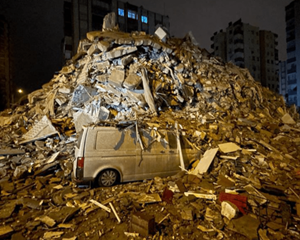Seismologists say Monday's magnitude 7.8 earthquake that hit Turkey and Syria is probably going to be one of the deadliest this decade.
地震学家称,本周一袭击土耳其和叙利亚的7.8级地震,可能是这十年来最致命的地震之一。
Only two others from 2013 to 2022 were of the same magnitude.
从2013年到2022年,只有另外两次地震与这次的震级相同。
Compared to the 6.2 quake that hit Italy in 2016 and killed some 300 people -- the Turkey-Syria earthquake released 250 times as much energy -- according to one expert.
一位专家表示,与2016年袭击意大利、造成约300人死亡的6.2级地震相比,土耳其-叙利亚地震释放的能量是前者的250倍。
So why was it so bad?
所以为什么这次地震如此严重?
The epicentre of the quake was in the Turkish province of Gaziantep and at the relatively shallow depth of about 11 miles on the East Anatolian Fault.
此次地震的震中位于土耳其的加济安泰普省,在东安纳托利亚断层约11英里深处。
It then radiated towards the northeast -- bringing devastation to central Turkey and Syria.
随后向东北方向辐射,给土耳其中部和叙利亚带来了破坏。

The severity was due to the fact that the East Anatolian Fault is a strike-slip fault.
受损程度如此严重是由于东安纳托利亚断层是一条走滑断层带。
In those, solid rock plates are pushing up against each other across a vertical fault line,
坚硬的岩石板块在垂直断层线上相互推挤,
building stress until one slips in a horizontal motion -- which releases a tremendous amount of strain.
压力不断增加,直到一块岩石最终水平滑动,释放出可能引发地震的巨大张力。
In Monday's quake there was a more than 62 mile rupture between the Anatolian and Arabian plates.
在周一的地震中,安纳托利亚板块和阿拉伯板块之间出现了超过62英里的断裂。
Eleven minutes after the initial quake, the region was hit by a 6.7-magnitude aftershock.
第一次地震发生仅11分钟后,该区域就发生了6.7级的余震。
A 7.5-magnitude quake came hours later, followed by another spasm in the afternoon.
几小时后又发生了一次7.5级的地震,接着是下午的余震。
Experts say activity is spreading to neighboring faults -- and seismicity may continue for a while.
专家表示,地震活动正在向邻近的断层蔓延,可能会持续一段时间。



